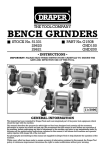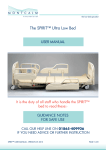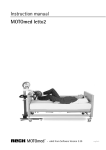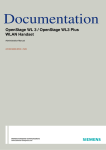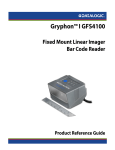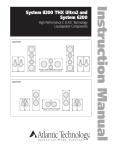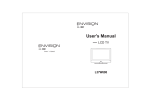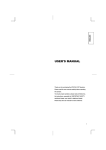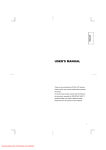Download Draper WTL30 Owner`s manual
Transcript
WOOD LATHE MODEL WTL30 STOCK No.55951 • INSTRUCTIONS • IMPORTANT: PLEASE READ THESE INSTRUCTIONS CAREFULLY TO ENSURE THE SAFE AND EFFECTIVE USE OF THIS TOOL. 08/99 VARIABLE SPEED WOOD LATHE ■ MODEL WTL30. ■ STOCK No.55951. Whilst every effort has been made to ensure accuracy of information given in this manual is correct at the time of going to print, the Draper Tools policy of continuous improvement determines the right to change specification without notice. CONTENTS: Wood lathe specification/guarantee ......................................................................................................3 Power supply ....................................................................................................................................... 4 General safety instructions for machine tools ...................................................................................... 5 Additional safety rules for wood lathes/Know your wood lathe ............................................................. 6 Unpacking ........................................................................................................................................... 6 Assembly/installation ...................................................................................................................... 7-11 Wood lathe adjustments.......................................................................................................................12 Woodturning operations .................................................................................................................13-14 Using woodworking chisels ............................................................................................................15-21 Optional accessories ...........................................................................................................................22 Trouble shooting..................................................................................................................................23 DECLARATION OF CONFORMITY We Draper Tools Ltd. Hursley Road, Chandlers Ford, Eastleigh, Hampshire. SO53 1YF. England. Declare under our sole responsibility that the product: Part Number:- WTL30. Stock Numbers: 55951. Description:- Variable speed wood lathe. To which this declaration relates is in conformity with the following directive(s) 98/37/EC, 73/23/EEC and 89/336/EEC, BSEN61029-1:1996. JOHN DRAPER Managing Director -2- SPECIFICATION Model No. ............................................................................................................................WTL30 Stock No. ................................................................................................................................55951 Woodturning capacity: Diameter .....................................................................................................................305mm (12") Length .........................................................................................................................941mm (37") Motor ...........................................................................................................................350W 1/2HP Voltage ..........................................................................................................................230V~50HZ Speeds ....................................................................................................................5 (V. Belt Drive) RPM.........................................................................................................460, 800, 1320, 2180, 3270 On/Off switch .......................................................................................................................No volt Spindle thread ................................................................................................................3/4" x 16 TPI Spindle taper ......................................................................................................................No.1 MT Overall length ....................................................................................................................1350mm Weight gross/nett ..............................................................................................................80/85kg. The typical sound pressure level of this tool is 70db(A). GUARANTEE Draper machine tools have been carefully tested and inspected before shipment and are guaranteed to be free from defective materials and workmanship for a period of 12 months from the date of purchase except where tools are hired out when the guarantee period is reduced to ninety days from the date of purchase. Should the machine develop any fault, please return the complete tool to your nearest authorized warranty repair agent or contact Draper Tools Limited, Chandler's Ford, Eastleigh, Hampshire, SO53 1YF. England. Telephone: (01703) 494344. If upon inspection it is found that the fault occurring is due from defective materials or workmanship, repairs will be carried out free of charge. This guarantee does not apply to normal wear and tear, nor does it cover any damage caused by misuse, careless or unsafe handling, alterations, accident, or repairs attempted or made by any personnel other than the authorized Draper warranty repair agent. This guarantee applies in lieu of any other guarantee expressed or implied and variations of its terms are not authorized. Your Draper guarantee is not effective unless you can produce upon request a dated receipt or invoice to verify your proof of purchase within the 12 month period. Please note that this guarantee is an additional benefit and does not affect your statutory rights. DRAPER TOOLS LIMITED -3- POWER SUPPLY CONNECTING YOUR MACHINE TO THE POWER SUPPLY: (230V ONLY) To eliminate the possibility of an electric shock your machine has been fitted with a BS approved, non rewireable moulded plug and cable which incorporates a fuse, the value of which is indicated on the pin face of the plug. Should the fuse need to be replaced an approved BS1362 fuse must be used of the same rating, marked thus . The fuse cover is detachable, never use the plug with the cover omitted. If a replacement fuse cover is required, ensure it is of the same colour as that visible on the pin face of the plug (i.e. red). Fuse covers are available from your Draper Tools stockist. If the fitted plug is not suitable, it should be cut off and destroyed. *The end of the cable should now be suitably prepared and the correct type of plug fitted. See below. *WARNING: A plug with bare flexible wires exposed is hazardous if engaged in a live power socket outlet. WARNING THIS APPLIANCE MUST BE EARTHED. Green and Yellow - Earth, Blue - Neutral, Brown - Live. As these colours may not correspond with the coloured markings identifying the terminals in your plug, proceed as follows: The wire which is coloured green and yellow must be connected to the terminal in the plug which is marked with the letter ‘E’ or by the earth symbol or coloured green or green and yellow. The wire which is coloured blue must be connected to the terminal which is marked with the letter 'N' or coloured black or blue. The wire which is coloured brown must be connected to the terminal which is marked with the letter 'L' or coloured red or brown. (N.B. Three phase machines must be connected by a qualified electrician). EXTENSION LEAD CHART: Extension lead sizes shown assure a voltage drop of not more than 5% at rated load of tool. Ampere rating (on Name plate) 3 6 13 1.0 1.0 1.0 1.25 1.5 1.25 1.5 1.5 1.5 2.5 Wire Size mm2 Extension cable length 7.5m 15m 22.5m 30m 45m 10 0.75 0.75 0.75 0.75 0.75 0.75 0.75 0.75 0.75 1.25 -4- GENERAL SAFETY INSTRUCTIONS FOR POWER TOOLS WARNING Please read the following instructions carefully, failure to do so could lead to serious personal injury. IMPORTANT Draper Tools Limited recommends that this machine should not be modified or used for any application other than that for which it was designed. If you are unsure of its relative applications do not hesitate to contact us in writing and we will advise you. 1. KNOW YOUR POWER TOOL Read and understand the owner's manual and labels affixed to the tool. Learn its application and limitations as well as the specific potential hazards peculiar to this tool. 2. KEEP WORK AREA CLEAN Cluttered areas and benches invite accidents. Floors must not be slippery due to oil or sawdust. 3. AVOID DANGEROUS ENVIRONMENTS Do not use power tools in damp or wet locations, or expose them to rain. Keep work area well lit. Provide adequate space surrounding the work area. Do not use in environments with a potentially explosive atmosphere. 4. KEEP CHILDREN AWAY All visitors should be kept a safe distance from work area. 5. STORED TOOLS When not being used, all tools should be stored in a dry, locked cupboard or out of the reach of children. 6. WEAR PROPER CLOTHING Do not wear loose clothing, neckties or jewellery (rings, wristwatches) to catch in moving parts. NONSLIP footwear is recommended. Wear protective hair covering to contain long hair. Roll long sleeves above the elbow. 7. USE SAFETY GOGGLES (Head Protection) Wear CE approved safety goggles at all times. Normal spectacles only have impact resistant lenses, they are NOT safety glasses. Also, use face or dust mask if application is dusty and ear protectors (plugs or muffs) during extended periods of operation. 8. NOISE LEVELS Some types of machines may have high noise levels when working. In such cases ear protection must be worn. 9. VIBRATION LEVELS Hand held power tools produce different vibration levels. You should always refer to the specifications and relevant Health and Safety guide. 10. DUST EXTRACTION If your tool is fitted with a dust extraction fitting, always ensure that it is connected and being used with a dust extractor. Vacuum cleaners can be used if suitable for the material being extracted. 11. PROTECT YOURSELF FROM ELECTRIC SHOCK When working with power tools, avoid contact with any earthed items (e.g. pipes, radiators, hobs and refrigerators, etc.). If you are using a power tool in extreme conditions (e.g. high humidity or generating metal dust), always use an RCD (residual current device) at the power socket. 12. STAY ALERT Always watch what you are doing and use common sense. Do not operate a power tool when you are tired or under the influence of alcohol or drugs. 13. WHEN WORKING OUT OF DOORS Only use extension leads designed for that purpose. 14. ACCESS TO MAINS SOCKET If a stationary machine is fitted with a moulded plug and cable, the machine should not be positioned so that access to the mains socket is restricted. 15. DISCONNECT POWER TO THE TOOL When not in use, before servicing and when changing accessories such as cutters, etc. 16. AVOID ACCIDENTAL STARTING Make sure the switch is in the OFF position before plugging the machine into the power supply. 17. NEVER LEAVE MACHINE RUNNING UNATTENDED Turn power off. Do not leave machine until it comes to a complete stop. 18. DO NOT ABUSE THE CORD Never carry the tool by the power cable or pull it from the socket. Keep the power cable away from heat, oil and sharp edges. 19. NEVER STAND ON TOOL Serious injury could occur if the tool is tipped or if the cutting tool is accidentally contacted. Do not store materials above or near the tool, so that it is necessary to stand on the tool to reach them. 20. CHECK DAMAGED PARTS Check for damage to parts, breakage of parts, mountings and any other conditions that may affect its operation. A guard or other part that is damaged should be properly repaired or replaced. 21. KEEP GUARDS IN PLACE And in working order. 22. MAINTAIN TOOLS WITH CARE Keep tools sharp and clean for the best and safest performance. Follow instructions for lubricating and changing accessories. All extension cables must be checked at regular intervals and replaced if damaged. Always keep the hand grips on the tool clean, dry and free of oil and grease. 23. USE RECOMMENDED ACCESSORIES Consult the owners manual for recommended accessories. Follow the instructions that accompany the accessories. The use of improper accessories may cause hazards. 24. REMOVE ADJUSTING KEYS AND WRENCHES Form a habit of checking to see that keys and adjusting wrenches are removed from the tool before turning it on. 25. SECURE WORK Use clamps or a vice to hold work. This frees both hands to operate the tool. 26. DO NOT OVERREACH Keep proper footing and balance at all times. 27. USE RIGHT TOOL Do not force the tool or attachment to do a job for which it was not designed. 28. DO NOT FORCE TOOL It will do the job better and safer at the rate for which it was designed. 29. DIRECTION OF FEED Feed work into a blade or cutter against the direction of rotation of the blade or cutter only. 30. WHEN DRILLING OR SCREWING INTO WALLS Always make sure there is no danger of hitting any hidden power cables, water or gas pipes in the wall. IMPORTANT NOTE Residual Risk. Although the safety instructions and operating manuals for our tools contain extensive instructions on safe working with power tools, every power tool involves a certain residual risk which can not be completely excluded by safety mechanisms. Power tools must therefore always be operated with caution ! -5- ADDITIONAL SAFETY RULES FOR WOOD LATHES FOR YOUR OWN SAFETY: Read and understand the instruction manual before operation. 1. Always wear eye protection which complies to a recognized standard. 2. Wear a mask or respirator when dust is generated. 3. Keep hands clear of moving parts. 4. Only use Draper approved accessories and spares. 5. Keep turning chisels sharp. 6. Keep pulley cover guards in place when working. 7. Never reach behind or beneath the workpiece. 8. Unplug from power supply before adjusting or servicing. 9. To avoid electric shock do not use in damp conditions or expose to rain. KNOW YOUR WOOD LATHE ✽✌ ✸✌ ✻✌ ✺✌ ✫✌ ✼✌ ✹✌ ✵✌ ✷✌ ✴✌ ✳✌ ✪✌ ✲✌ ✱✌ ✯✌ ✬✌ ✭✌ ✾✌ ✶✌ ✮✌ ✪✌ ✫✌ ✬✌ ✭✌ ✮✌ ✯✌ ✰✌ ✱✌ ✲✌ ✳✌ ✰✌ ✴✌ NAMEPLATE – Provides information such as Model No., Stock No., Serial No., Specification, etc. DRIVE BELT – MOTOR PULLEY – 5 speed manual change. ON/OFF SWITCH – No volt overload protection. TOOL REST CLAMPING BRACKET TOOL REST LOCK HANDLES – Locks tool rest in required position. BED – Supports tailstock/toolrest. TAILSTOCK ADJUSTMENT WHEEL TAILSTOCK ADJUSTMENT LOCKING HANDLE – Locks tailstock barrel in position. LIVE CENTRE – Acts as a pivot for the free end of the workpiece. ✵✌ ✶✌ ✷✌ ✸✌ ✹✌ ✺✌ ✻✌ ✼✌ ✽✌ ✾✌ -6- TOOL REST – Supports chisel. MOTOR DRIVE SPUR – Drive centre for workpiece. SPINDLE PULLEY – 5 speed, manual change. PULLEY COVER – Protects user from moving parts. TAILSTOCK ASSEMBLY – Supports long workpieces. OUTBOARD SPINDLE END COVER INDEXING PIN – For locking spindle pulley. TOOL REST ASSEMBLY HEADSTOCK SPINDLE – With R.H. and L.H. thread for inside and outside bowl turning. Call the Power Division Helpline (01703) 494344 if you have any enquiries, eg. problems with assembly, apparent missing/damage parts, help with accessories available or technical advice. UNPACKING Carefully unpack the wood lathe and all the loose parts from the carton. Fig.1. illustrates the wood lathe and all the associated parts that are packed in the carton. Check that all the parts are present. Fig.1. ASSEMBLY IMPORTANT: To correctly assemble and adjust this wood lathe, please read the following instructions carefully. Fig.2. NOTE: To secure the wood lathe to the workbench/stand you will need to obtain the following nuts, bolts and washers:- (THESE ARE NOT SUPPLIED). 4 x 5⁄16″ x 2″ bolts and nuts, 4 x 5/16″ lockwashers, 4 x 5/16″ standard washers, 1 x 1/4″ x 31⁄2″ long hex. head bolt and nut, 1 x 1/4″ standard washer, 1 x 1/4″ lockwasher, 3 x wood or self-tapping screws. 155mm (619⁄64″) 35mm (43⁄8″) SECURING THE HEADSTOCK TO THE WORKBENCH/STAND 105mm (4 ⁄4″) 1 Note: Position your wood lathe on the workbench/ stand before drilling location holes, this will ensure a totally correct alignment. Mark and drill two 9.5mm (3/8″) holes ✪✌ Fig.2. in the top of the workbench/stand as shown in Fig. 2. Ensure the headstock is positioned so you do not drill into the legs or support rails underneath. -7- ASSEMBLY cont’d Carefully lift the headstock ✫✌ Fig.3. onto the workbench/stand. Now line up the holes ✬✌ in the base of the headstock with the holes you have drilled in the top of the workbench/stand. Insert a 5/16″ carriage bolt ✭✌ into each of the two holes ✬✌. Now place a flat washer, lock washer and nut onto each of the bolts. TIGHTEN NUTS FINGER TIGHT ONLY. Fig.3. ✭✌ ✫✌ ASSEMBLING THE BED HALVES The two bed halves are assembled by inserting the connecting end ✮✌ see Fig.4. (plugged end with threaded hole in centre of the plug) of the headstock half into the machined inside diameter of the tailstock end ✯✌. Insert the bed foot ✰✌ Fig.5. into the open end of the tailstock half of the bed tube ✯✌. Now insert the bed clamping bolt ✱✌ through the hole in the foot into the tailstock bed half. Locate the end of the bolt in the threaded hole in the end of the headstock bed half. Start the threads but do not tighten. ✬✌ Fig.4. ✮✌ ✯✌ Fig.5. ✱✌ ✯✌ ✰✌ Align the two keys ✲✌ Fig.6. (the strips of metal bar fastened to each bed half by the screws) with each other so they are exactly in line. (This alignment is necessary so that the tailstock assembly ✳✌ and tool rest base assembly ✴✌ will slide freely over the joint between the two halves). Align the bed half keys by placing a metal straight edge against one side of the keys. Now slide the straight edge across the joint from side to side. If there is a “click” or snagging of the straight edge at the joint, it will be obvious what relative direction the two halves of the bed will have to be rotated to achieve alignment. Repeat this exercise for the other side until you are satisfied alignment has been obtained. (Ensure all screws holding the keys are tight, including the loose screw in Fig.4.) Now position the foot ✰✌, so that the keyways on the bed halves will be facing straight down when the foot is bolted to the bench, now carefully tighten bolt ✱✌ using a spanner. Recheck the alignment of the keyways and readjust the two bed halves if necessary. -8- Fig.6. ✳✌ ✴✌ ✲✌ ✰✌ ✱✌ ASSEMBLY cont’d SECURING THE BED TO THE HEADSTOCK Slide the tailstock assembly ✳✌ Fig.7. and tool rest assembly ✴✌ onto the bed as shown in Fig.7. Now insert the headstock bed bar ✮✌ into the locating hole ✵✌ in the headstock assembly, until the end of the keyway is flush with the inboard side of the headstock. Position the lathe on the bench, so that the bed runs parallel with the front edge of the bench. Fig.7. ✵✌ ✳✌ ✮✌ ✴✌ Position the bed in the headstock assembly so that the key(s) are directly under the centre of the bed and facing towards the bench. Tighten the set screw ✶✌ in the headstock located on the motor side in line with the centre line of the bed. Check that the base of foot ✰✌ Fig.8. is flat on the bench. If it is not, loosen bolt ✱✌ several turns and reposition the foot, being very careful not to disturb the key alignment. Retighten bolt ✱✌. Fig.8. ✱✌ ✰✌ ✶✌ Securing the bedfoot to the workbench or stand. When you are satisfied the wood lathe is correctly set up, mark on the workbench/stand the two locating holes ✷✌ in the foot ✰✌ Fig.9. and drill two 9.5mm (3/8″) holes in the workbench/stand. Insert two 5 /16″ x 2″ bolts through the holes in the foot. Place a flat washer, lock washer and finally nut on each of the bolts and then tighten securely with a spanner. Now tighten the two headstock securing bolts using a spanner. Fig.9. ✷✌ ✰✌ For additional rigidity drill a 5/16″ hole through the bench using the hole ✸✌ Fig.10. provided in the hinged bracket as a pilot. Insert the 1/4″ x 31/2″ long hex. head bolt and plain washer into the hole and push through the bench top. Now place the plain washer, spring lockwasher and nut on to the bolt and tighten securely using a spanner. Fig.10. ✸✌ - 9- ASSEMBLY cont’d Next, if the workbench or stand is large enough, secure the base of the inner pulley cover ✹✌ to the workbench/stand using three wood or self-tapping screws ✺✌. Open the pulley cover and find three holes ✻✌ in the bottom flange of the inner guard. Ensure that the flange is parallel to the bolt and that the cover opens and closes easily. Drill a pilot hole in each of the three flange holes and secure to the workbench/stand using the three screws. Fig.11. ✹✌ DRIVE SPUR AND CUP CENTRE ASSEMBLY Locate both the drive spur and live centre from the loose parts supplied with the wood lathe and insert the drive spur ✼✌ into the headstock spindle and the live centre ✽✌ into the tailstock barrel as shown in Fig.12 NOTE: Do not drive or hammer centres into the headstock spindle or tailstock barrel as removal may be difficult. Use a soft faced hammer, block of wood or gently tap them using a small hammer and piece of softwood as shown in Fig.12. REMOVAL: To remove the drive spur from the headstock spindle, hold the spindle pulley ✾✌ Fig.13. With one hand and using a spanner turn the hex. nut anti-clockwise until the drive spur is ejected. ✻✌ ✺✌ Fig.12. ✼✌ ✽✌ Fig.13. ✾✌ To remove the live centre from the tailstock barrel, insert a 1/4″ wooden dowel or brass rod through the hole in the tailstock barrel as shown in Fig.14. hold the centre with one hand and gently tap the dowel or rod with a hammer until it is released. Fig.14. LIVE CENTRE TAILSTOCK BARREL DOWEL OR BRASS ROD - 10- ASSEMBLY cont’d TAILSTOCK/BED KEYWAY ADJUSTMENT The tailstock ✿✌ Fig. 15 supports the workpiece when spindle turning. To prevent the tailstock roofing during turning, the tailstock is fitted with an adjustable set screw ❀✌. This set screw bears against the keyway ❂✌ on the underside of the bed. To adjust refer to Fig.15. and proceed as follows; with the tailstock lock ❁✌ loosened, tighten the adjustable screw ❀✌ moderately against the keyway ❂✌, then loosen the screw by about 1⁄4 turn. Now with lock ❁✌ still loosened, slide the tailstock along the full length of the bed. If it binds or sticks at any one point, loosen the adjustable screw ❀✌ just enough to allow the tailstock to slide smoothly. If the tailstock can be rocked, tighten the adjustable screw just enough so that it will not bind when sliding the full length of the bed. ✿✌ Fig.15. ❂✌ ❂✌ ❁✌ ❀✌ Fig.17. Fig.16. INSTALLING THE BRASS SLUGS IN LOCKS Brass slugs ❃✌ Fig.16. are required under the lock bolts ❁✌ of both the tailstock and the tool rest base. The purpose of these slugs is to securely grip the bed when locked down without damaging the bed. Locate the two brass slugs ❃✌ from the loose parts supplied. Insert a brass slug into the threaded hole of tailstock Fig.17. and into tool rest (not shown) and screw the lock handles into the holes until tight. Now screw the other two clamping handles into their locating holes. ALIGNMENT OF TAILSTOCK CUP CENTRE TO HEADSTOCK DRIVE SPUR The drive spur and live centre are used for spindle turning and should always be in alignment. To align the centres, refer to Fig.18. and proceed as follows: Slice the tailstock towards the headstock, so that the two points of the centres are very close, but not actually touching, tighten the tailstock lock. If the two centres are aligned proceed to the next section. If the centres are not in line loosen the foot bolt ✱✌ Fig.19. by about two turns (do not drive the bolt forward as this could loosen the bed connector clamp and alignment of the key way will be lost). Using a 3/16″ hex. key wrench loosen the hex. socket screw ✪✌ located on the rear of the headstock which secures the bed. Gently swing the tailstock, so that the two points are in line, then retighten the set screw ✪✌ and the foot bolt ✱✌. ❁✌ Fig.18. Fig.19. ✪✌ ✱✌ - 11- ❃✌ WOOD LATHE ADJUSTMENTS CHANGING SPEEDS Fig.20. shows the belt on the outside end of the pulleys. In this position the spindle will turn at 2980rpm. Should you want to run the lathe at a slower speed, you must move the belt inwards. IMPORTANT: Ensure the wood lathe is disconnected from the power supply before making any adjustments. If you want to increase the speed move the belt outwards. The simplest way to move the drive belt is as follows: Rotate the motor pulley anti-clockwise with your left hand, whilst pushing the belt with your right hand. Continue rotating the pulley until the belt climbs down to the next step on the motor pulley. Now rotate the spindle pulley clockwise with your right hand, while pushing on the belt with your left hand. The belt will climb up to the next step of the the spindle pulley or rotate the spindle pulley clockwise with your right hand and pull on the belt whilst still rotating the pulley until it climbs down to the next step. Now rotate the motor pulley anti-clockwise with your left hand, while pulling on the belt with your right hand. The belt will climb up into the next larger step. BELT TENSION ADJUSTMENT: The belt is tensioned by the weight of the motor pivoting on the motor mounting bracket. To decrease the belt tension, tighten the adjustable bolt ✪✌ Fig.21., located on the corner of the motor mounting bracket. This will restrict the downward travel, loosening the bolt will increase belt tension. - 12- Fig.20. Fig.21. ✪✌ WOODTURNING OPERATIONS Read and understand the following pages of this manual as they explain and illustrate the correct use of the turning tools, positioning of the tool rest and other information to help you. Fig.22. If you are new to woodturning, we suggest that you practice using the various wood turning chisels supplied with the wood lathe. Start with small spindle turning. SPINDLE TURNING: Select a piece of softwood approximately 2 x 2 x 12″. Draw diagonal lines on each end of the piece of wood to locate the centre. See Fig.22. On one end of the piece of wood drill a 1/16″ hole, 1/4″ deep in the centre. This is for the drive spur. The uncut end is for the live centre. Place the point of the live centre on the wood where the diagonal lines cross. Carefully drive the live centre into the wood using a wooden mallet or soft faced hammer, place a piece of wood on the end of the live centre to protect it. See Fig.23. Now remove the live centre and carefully drive the drive spur into the opposite end. Make sure the spurs are in the saw cuts and remove the drive spur. Ensure that both the drive spur and live centre are clean. Insert the drive spur into the headstock and the live centre into the tailstock, tap them lightly with a piece of wood. DO NOT DRIVE THEM IN. Ensuring the diagonally cut end is against the drive spur place the piece of wood between the centres and lock the tailstock. See Fig.24. Move the live centre into the wood by turning the barrel adjustment wheel at the top of the tailstock. Check that the drive spur and live centre are “seated” in the holes made previously. The wood should be rotated by hand while tensioning the barrel adjustment wheel. Select the required tool rest and position approximately 1⁄8″ away from the corners of the wood and 1⁄8″ above the centre line, see Fig.25. Lock the tool rest and tool rest base in position. Referring to the speed chart on the pulley cover lock up the speed for “roughing” 2″ square turning, up to 18″ long. Move the v-belt to the required position, rotate the wood and check that the corners do not strike the tool rest and that the indexing pin is not engaged. Fig.23. WASTE PIECE OF TIMBER Fig.24. Fig.25. WOOD TOOL REST - 13- WOODTURNING OPERATIONS cont’d INDEXING: Fig.26. There are 36 equally spaced holes in the spindle pulley, see Fig.26. The index pin will locate into one of these holes and will stop the spindle from turning whilst you mark the workpiece. For example, to locate the position of six spokes in a wheel pull the index pin outward and turn it so that the small cross pin locates in the slot. This will allow the index pin to engage in one of the holes in the pulley and will prevent the spindle from turning. Adjust the tool rest so it is approximately at the centre line and make a mark. Now pull out the index pin and slowly rotate the workpiece until the pin locates into the next hole in the pulley. Do this six times and put a second mark on the workpiece. See Figs.27. and 28. The two marks will be spaced 60º apart. Continue this operation until six spokes are marked at 60º apart. Spindle turning can be divided in the same way. Fig.27. WARNING: THE INDEXING PIN MUST BE DISENGAGED FOR ALL OTHER OPERATIONS. OUTBOARD TURNING: This technique would be used when the workpiece is too large to mount conventionally. It is the same as standard face plate turning except that because of the size of the workpiece the turning speed should be kept to a minimum. If you intend outboard turning you must build a stand similar to the one shown in Fig.29. This stand will be used as a tool rest, ensure that when the chisel is resting on the top of the stand it lines up with the centre line of the workpiece. DO NOT PUSH THIS SUPPORT WHEN TURNING. DO NOT MOUNT A WORKPIECE SO LARGE THAT THE MOTOR STRAINS TO TURN. When experimenting with the technique use softwood, use heavier hardwood when you are more confident. The outboard turning spindle is covered by the red plastic cover located on the pulley cover assembly. The thread size on the spindle is 3⁄4″ - 16 left hand thread. (See optional accessories, page 41, for left hand threaded face plates and other accessories). - 14- Fig.28. Fig.29. WOODTURNING OPERATIONS cont’d USING WOODWORKING CHISELS: Professional woodturning chisels have handles approximately 10″ long. This provides the operator with good grip and leverage. A sharp chisel will be much easier to work with and will give the job a cleaner finish. Fig.30 shows the six most commonly used types of turning chisel. Fig.30. GOUGE SKEW PARTING TOOL SPEAR POINT FLAT NOSE ROUND NOSE THE THEORY OF TURNING: There are two types of turning chisel. These are: 1) those intended primarily for cutting, 2) those used only for scraping. The cutting chisels are the gouge, skew and parting type. These are sharpened to a razor edge by honing on both sides. The scraping chisels are the flat nose, round nose and spear point. These are not hones on the flat sides – the wire edges produced by scraping are left on to aid in the scraping process. Fig.31. shows the two types of chisel. CUTTING AND SCRAPING: Fig.31. To make a cut, the chisel should be held so that the sharp edge actually digs into the revolving workpiece, shavings should now peel off. To scrape, the chisel should be held at a right angle to the surface of the workpiece, fine pieces of wood will be produced when scraping instead of shavings. See Fig.32. Many operations require the cutting chisel to be used for scraping but scraping chisels are very rarely used for cutting. Scraping will blunt/dull a chisel much faster especially when using razor sharp cutting chisels. Cutting is much faster then scraping and produces a much smoother finish. Cutting is more difficult than scraping, but scraping is more precise and easier to control. CUTTING CHISEL Fig.32. CUTTING - 15- SCRAPING CHISEL SCRAPING WOODTURNING OPERATIONS cont’d KNOWING WHEN TO CUT AND Fig.33. WHEN TO SCRAPE: There are two different approaches to the work when turning. The first is toward a circumference of the workpiece (eg. when turning down the outer surface of a cylinder or the inner wall of a hollow round box). Using this method, the surface being turned travels CIRCUMFERENCE under the edge of the chisel like an endless belt. The APPROACH second approach is toward the diameter of the workpiece (as when turning the face when faceplate DIAMETER turning, or the side of a large shoulder when spindle APPROACH turning) using this method, the surface being turned rotates like a disc under the chisel edge. Some jobs will require both methods being used. See Fig.33. Either a cutting or scraping action may be used when the method used is towards the circumference – the shaving will come off like the peel from a potato. Only scraping can be used when the method used is towards the diameter. The reason for this is obvious when you consider that faceplate turning nearly always requires the removal of wood across the grain. Wood does not peel easily when turning across the grain and any attempt made to use cutting methods will probably result in damage to the workpiece and the chisel being thrown by the workpiece. It therefore follows that a cutting action is used for general spindle turning operations, while the majority of faceplate turning is carried out by the scraping method. When both methods are to be used, you will have to judge by the feel of the workpiece when to stop cutting and start scraping. NEVER try to cut when it becomes difficult to hold the chisel against the wood grain. - 16- WOODTURNING OPERATIONS cont’d POSITIONING THE TOOL REST FOR CIRCUMFERENCE TURNING: FORCE Fig.34. STEADY THRUST AGAINST HANDS When turning the object is to pierce the outer surface of the wood to a desired depth, then to hold the chisel steady with the bevel edge parallel to the work circumference, so that the chisel will peel off a shaving at this desired depth. The only sure method of holding the chisel steady is to rest the bevel against the work, as shown in Fig.34. When the tool rest is at the correct height (Fig.34.) the chisel can be held with the bevel against the workpiece, the tool rest will act as a fulcrum to support the chisel against the downward force of the revolving workpiece. If the tool rest is positioned too low, so that the chisel bevel is held out from the workpiece, (Fig.35) the cutting edge of the chisel will continue to dig deeper into the workpiece until the “bite” becomes so deep that you have difficulty holding the chisel, then the chisel will begin to bounce or chatter against the workpiece. BEVEL AGAINST WORK CHISEL CUTTING PROPERLY Fig.35. If the tool rest is positioned too low, the chisel will be held extremely high to position the bevel of the chisel against the workpiece as shown in Fig. 36 then the tool rest will lose its value as a fulcrum and the downward force of the revolving workpiece will kick the chisel back and possibly out of your hands. If the tool rest is positioned too high and the chisel is correctly positioned for cutting it will strike near the top of the workpiece where the direction of the force exerted by the workpiece is almost horizontal and will again result in kickback as shown in Fig.37. NO SUPPORT FOR BEVEL POINT DIGGING IN CHATTER REST TOO LOW CHISEL TOO HORIZONTAL Fig.36. KICKBACK REST TOO LOW CHISEL TOO HIGH Fig.37. KICKBACK CHISEL REST TOO HIGH ON WORK - 17- WOODTURNING OPERATIONS cont’d If the tool rest is positioned too far away from the workpiece as shown in Fig.38., the chisel when correctly held will again be too high on the workpiece. You will also find that you have less leverage on your side of the tool rest and it will be very difficult to hold the chisel. Fig.38. HANDLE KICKED UP With a large diameter workpiece, the tool rest can be above the workpiece centreline and further out from the surface of the workpiece than normal as shown in Fig.39. With a small diameter workpiece the tool rest should be closer to the surface workpiece than normal. As the workpiece gets smaller the rest should be repositioned as shown in Fig.40. REST TOO DISTANT – CHISEL TOO HIGH, POINT TOO FAR FROM REST Fig.39. LARGE DIAMETER POSITIONING THE TOOL REST FOR CIRCUMFERENCE SCRAPING: When scraping, the position of the tool rest is not as critical as it is for cutting operations. The chisel is normally held horizontally, although it can be held at an angle to reach difficult places. The wire edge of the chisel does the scraping. Fig.40 and 41 show the result of a chisel being too low or too high. Fig.42 and 43. show the chisel positioned correctly on the tool rest. Fig.40. Fig.41. SMALL DIAMETER NO STOCK REMOVED Fig.42. Fig.43. EDGE DIGGING IN - 18- WOODTURNING OPERATIONS cont’d POSITIONING THE TOOL REST FOR DIAMETER SCRAPING: Fig.44. When diameter scraping, the area to the right of the centre is moving upward. (See Fig.44). If the chisel is laced in this area it will simply be carried up and off the tool rest, possibly out of your hands. So all diameter approach operations MUST be done at the left of the centre. Three different chisel contact points are shown in Fig.45. Note that when the chisel is positioned above or below the workpiece centre, the work surface sweeps past the chisel edge at an angle and will tend to carry the chisel in one direction along the tool rest. Only when the chisel contacts the workpiece centre line does the workpiece pass squarely under the edge of the chisel. This then is the position in which it is easiest to hold the chisel steady. To obtain the position place the rest approximately 1⁄8″ below the centre. USING A GOUGE CHISEL: 1 Fig.45. TOOL REST Three gouges – ⁄4″, ⁄2″ and ⁄4″ sizes are usually sufficient for home workshop turning, but other sizes are available (refer to the Draper Catalogue). A gouge chisel is normally used for rough circumference turning or turning raw stock down to a cylinder of workable size. It is best used for rapid removal of the workpiece, but will not produce such a smooth finish, but with practice it can be used for cutting coves, for shaping long cuts and is also useful for scraping. 1 TOOL REST 3 Fig.46. CUTTING EDGE ADVANCED When used for cutting, the gouge is always held with the convex side down and should be rolled approximately 30º to 45º in the direction in which it is being advanced along the rest, the cutting edge would be a little in advance of the handle, see Figs. 46 and 47. Fig.47. WRONG - 19- RIGHT WOODTURNING OPERATIONS cont’d USING A SKEW CHISEL Two skew chisels – 1⁄2″ and 1″ are all that are required for general use although other sizes are available. (Refer to the Draper Catalogue). This chisel is used mostly for making finished cuts, to cut vees and beads and square shoulders. When correctly used it will produce the best finish that can be obtained with a chisel. It should not be used for scraping as this will quickly dull it. For finish cutting the skew should be held with the cutting edge considerably in advance of the handle and should be bevel side down. Always keep the base of the bevel against the work. Good practice is to place the skew well over the workpiece and pull it back until the edge begins to cut; then swing the handle into position to advance the cut. Both the tow and the heel of the skew can be used for making light cuts; but do not penetrate the wood too deeply without cutting clearances as you may burn the tip of the tool. Refer to Figs. 48, 49, 50, 51 and 52. Fig.48. SWING TOOL PULL BACK Fig.49. PATH OF CUT DIRECTION OF CUT Fig.50. USING TOE Fig.51. NO SUPPORT Fig.52. EDGE DOES NOT CUT USING HEEL - 20- WOODTURNING OPERATIONS cont’d USING A PARTING CHISEL Fig.53. A parting chisel has one primary purpose – to cut straight into the workpiece as deep as desired, or all the way through the workpiece to make a cut off. This is a very narrow chisel approximately 1⁄8″ wide and is shaped to cut its own clearance, so the cutting edge will not burn. But when used as a scraper, it should be backed off at regular intervals to prevent overheating. See Figs. 53 and 54. CUTTING USING SCRAPING CHISELS Finally, three more types of chisel should complete the list of chisels for the average craftsman, these and 1⁄2″ spear point, 1⁄2″ round nose and a 1″ flat node. Each of these chisels may be purchased in various sizes, (refer to the Draper Catalogue) for special jobs. All of these are very useful for diameter scraping (see Figs. 55, 56 and 57) operations and for circumference scraping, when cutting methods cannot be employed. Fig.54. SCRAPING The spear point chisel is used for fine scraping and delicate operations such as the forming of beads, parallel grooves and shallow vees. Edges and bowl contours can be rounded with the round nose chisel. Any flat surface can be scraped with the flat nose chisel. Fig.55. SPEAR POINT Fig.56. Fig.57. FLAT NOSE ROUND NOSE - 21- OPTIONAL ACCESSORIES WTL30 WOOD LATHE ACCESSORIES The following accessories are available from your local Draper Power Stockist. Wood lathe stand Part No.AWL12 Stock No.29873 Tailstock chuck and arbor set Part No.AWL1 Stock No.29422 Cup turning chuck Part No.AWL2 Stock No.29423 Screw chuck Part No.AWL3 Stock No.29424 Left hand thread face plate Part No.AWL6 Stock No.29427 Right hand thread face plate Part No.AWL8 Stock No.29429 Combination chuck Part No.AWL40 Stock No.37168 Face shield Part No.FS8 Stock No.33831 Turning chisel hobby set Part No.AWL5 Stock No.29426 For a comprehensive range of wood lathe accessories refer to the Draper Catalogue. - 22- TROUBLESHOOTING CHART NOTE: Repairs should only be carried out by a qualified person. Trouble Probable Cause Remedy Motor will not run. 1. Defective On-Off switch. Defective mains lead. 1. Replace defective parts before using lathe again. 2. Burned out motor. 2. Any attempt to repair this motor may cause a HAZARD unless repair is done by a qualified service technician. 3. Blown fuse. 3. Replace fuse. Lathe slows down when turning. 1. V-belt too loose. 1. Adjust belt tension, see Belt Tension Page 12. (G3). Tailstock rocks back and forth excessively. 1. Adjusting screw is too loose. 1. Adjust screw. See Assembly Section Page 11. (F15). Headstock loose on bed. 1. Set screw not tight. 1. Tighten set screw. See Assembly Section Page 9. (F8). Wood burns at tailstock end. 1. Live centre too tight or not lubricated. 1. Back off tailstock barrel and lubricate live centre. See Basic Lathe Operation Section, “Spindle Turning”. DRAPER HELPLINE: (01703) 494344 - 23 - DRAPER TOOLS LTD. Hursley Road, Chandler's Ford, Eastleigh, Hants. SO53 1YF. England. Tel: (01703) 266355. Fax: (01703) 260784. YOUR DRAPER STOCKIST Published by Draper Tools Ltd. No part of this publication may be reproduced, stored in a retrieval system or transmitted in any form or by any means, electronic, mechanical, photocopying, recording or otherwise without prior permission in writing from Draper Tools Ltd.
























